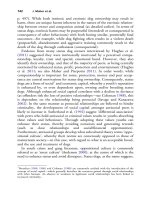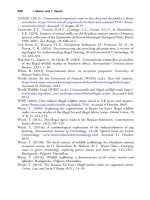The palgrave international handbook of a 266
Bạn đang xem bản rút gọn của tài liệu. Xem và tải ngay bản đầy đủ của tài liệu tại đây (37.64 KB, 1 trang )
262
R. White
The debates over the ways in which ‘feral’ and ‘invasive’ animals are
approached provide a useful summary of conflicting views pertaining to human
intervention. Invasive species are seen as a threat to local species in the same way
that ill animals are seen as a threat to local animal populations. More generally,
from the perspective of humans, certain creatures are by their very nature hostile
to human interests. As such, they demand action to eradicate or control them in
order to protect humans from harm. This applies to ‘vermin, pests and parasites’
that cannot adjust their behaviour and with which there is no possibility of
communication or compromise. If left unchecked, they would create ecological
havoc and harm to humans—and to other species (Anderson 2004).
Animals have rights, but which and how these are enforced are variable
depending upon natural and social contexts (Anderson 2004; White 2013).
As has been observed by some writers (Cazaux 1999), consideration of
human practices that are detrimental to the well-being of animals, such as
loss and fragmentation of habitat, tend to focus on the effects regarding
animal populations of a certain species (matters pertaining to the threat of
extinction). Less attention is paid to the consequences of broad trends to the
well-being of animals as individual subjects (see Sollund 2012).
Ethical and moral dilemmas involving animals—in life and death situations—also extend to instances where individual animals of one species are
sacrificed for the sake of the preservation of an entire other species, which can
be either plant or animal.
In a 1996 case, the US Fish and Wildlife Service moved to poison 6,000 gulls
at Monomoy National Wildlife Refuge off Cape Cod, in order to save 35
piping plovers, an endangered species. … San Clemente Island, off the coast of
California, has both endemic plant species and a population of feral goats,
introduced by Spanish sailors two centuries ago. To protect plants numbering
in the few hundreds, the Fish and Wildlife Service and the US Navy have shot
tens of thousands of feral goats. (Rolston 2010, pp. 605–606).
This represents cases where the so-called ethic of species has triumphed. The
death of individual creatures has been weighed up against the potential
demise of whole species. While objectionable from the point of view of
killing animals, unless suitable alternatives for relocation are possible or
available, there is a moral justification for such acts insofar as they allow
future and more diverse life to flourish. Likewise, threats to those habitats
that service a wide variety of species may mean human intervention to ‘cull’
the ‘offending’ creatures—as in the case of expanding populations of kangaroo in Canberra that promised to completely denude the landscape and
thereby ruin the survival chances of all species in the same vicinity.









